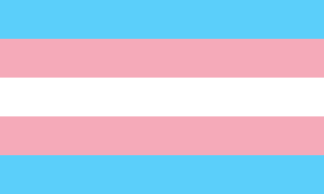Bigender
| Part of a series on |
| Transgender topics |
|---|
 |
|
Health care and medicine
|
|
Rights issues |
|
Society and culture |
|
By country
|
|
|
Bigender, bi-gender or dual gender is a gender identity that includes any two gender identities and behaviors. Some bigender individuals express two distinct personas, which may be feminine, masculine, agender, androgyne, or other gender identities; others find that they identify as two genders simultaneously. It is recognized by the American Psychological Association (APA) as a subset of the transgender group. A 1999 survey conducted by the San Francisco Department of Public Health observed that, among the transgender community, less than 3% of those who were assigned male at birth and less than 8% of those who were assigned female at birth identified as bigender.[1]
Description
A bigender gender-identity has been described as varying over time between two extremes. These periods can be anywhere from a few hours to a few years and there is no limit to the number of times that it may change.[2] A student at the University of Missouri, Kansas City, described the back and forth shift, saying:
| “ | Some days I wake up and think 'Why am I in this body?' [while] most days I wake up and think, 'What was I thinking yesterday?'[3] | ” |
Identifying as bigender is typically understood to mean that one identifies as both male and female or moves between a masculine gender expression and feminine gender expression with little middle ground, or both. This is different from identifying as genderfluid, as those who identify as genderfluid may not go back and forth between any fixed gender identities and may experience an entire range or spectrum of identities over time.[4]
Alternating gender incongruity
In 2012, researchers Vilayanur S. Ramachandran and Laura K. Case studied a subset of bigender people who have reported that switches in gender are typically unwanted and involuntary and occur when the individual would rather remain in the other gender. They named this condition alternating gender incongruity (AGI).[5] There is no indication that AGI is a common type of bigenderism, and the study did not attempt to study the broader group of bigender people who do not have AGI.
Ramachandran and Case theorized that the alternation of gender states in people with AGI is not just explained by the socially constructed nature of gender. Individuals In the study, more than half of those studied reported having "phantom limb" experiences—such as experiencing phantom erections when the body itself did not have a penis. Those that reported feeling these phantom parts rated them as moderate in strength (an average of 2.9 on a 5-point scale). The study also revealed a high number of people with bipolar disorder (9 out of 32). Additionally, ambidextrous handedness occurred at a higher rate in AGI respondents.[5]
According to Case and Ramachandan, these findings suggest that there is a biological basis of AGI bigenderism and hypothesized that it may correspond to an unusual degree of hemispheric switching, or when dominance switches from one hemisphere to the other during a single behavior, and callosal suppression of sex-appropriate body maps in the parietal cortex and its reciprocal connections with the insula and hypothalamus. They propose that "coordination between shifts in brain connectivity, autonomic response, hormone release, and dynamic representation of body gender might together create the sense of gender alternation experiencing by many bigender individuals". These researchers also disagree with the separation between neurological and psychological conditions and instead predict that alternating gender incongruity is a neuropsychiatric condition, but more research is needed to confirm this.[5]
See also
References
- ↑ Clements, K. San Francisco Department of Public Health, 1999
- ↑ Jackson-Edwards, Phoebe (2014-10-31). "It hit me that I was two genders: Bizarre life of bi-gender Ryan (or Ria)". Mirror.co.uk.
- ↑ Schulman, Michael (2013-01-02). "Generation LGBTQIA" (PDF). The New York Times.
- ↑ Roxie, Marilyn (2011-07-01). "How do you know if you're genderfluid or just bigender?". Genderqueer and Non-Binary Identities.
- 1 2 3 Case LK; Ramachandran VS (2012). "Alternating gender incongruity: A new neuropsychiatric syndrome providing insight into the dynamic plasticity of brain-sex". Medical Hypotheses. 78 (5): 626–631. doi:10.1016/j.mehy.2012.01.041. PMID 22364652.
External links
- Invisibilia - Paige's Story (audio interview)
